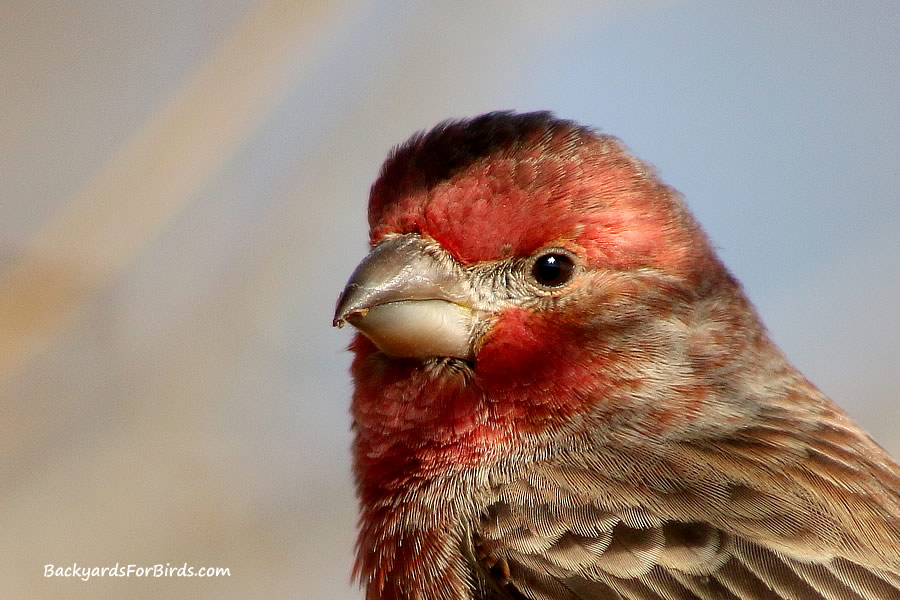Bird watching in your own backyard can be a very relaxing and enjoyable part of the day.
For me at least, there is nothing quite like ditching technology for a while and simply plopping down in a comfortable chair to enjoy the sights and sounds of house finches interacting with one another in my own yard.
It literally helps me unwind and, for a short time each day, I can get away from the stress and anxiety our fast-paced modern society oftentimes brings us and just sit and relax for a bit.
Don’t get me wrong, however, I do like the modern conveniences and technologies we have at our disposal, for without it I couldn’t blog about one of my favorite pastimes, bird watching.

But if truth be told, however, with those modern conveniences and technologies comes headaches, high blood pressure, and anxieties.
Believe me, it’s actually quite soothing to put the phone down, close the laptop, disconnect from the blogosphere for a while, and just watch nature be, well, nature.
Backyard birding is, in fact, a great way to not only rejuvenate the soul but also enjoy and even learn about nature so close to home.
I have been interested in and watching birds in both my own and other family members backyards for over four decades and it is still one of the most favorite things I do.
It’s easy and fairly inexpensive to get started with and backyard birding can be done in almost any yard of almost any size.
It’s a simple and easy hobby to get started with and after spending a little time and effort making some basic adjustments, anyone can attract a variety of birds, possibly including the beautiful and wide-spread house finch, to their own yard throughout the year.
Simply put, house finches are one of the most common and easiest birds to attract to a backyard.
We have them at our feeders year-round and this past summer a pair of finches ended up nesting in one of our yards for the first time.
It only took a few simple adjustments to this small quarter-acre suburban lot but after doing so, we now attract a steady stream of these beautiful birds each and every day of the year.
Some of the changes we made are quite simple and can be done immediately while others may take some time to implement.
They are all fairly easy and as we soon found out, they will not only help attract house finches but a variety of other local birds as well.
Where are house finches found?
The house finch can be found in much of the United States and Mexico.
Originally a bird found in the western United States, the house finch is believed to have been artificially introduced into the eastern portion of the county and has since expanded its’ range to cover most of the United States.
You will find house finches in cities, suburbs, farms, and canyons. They are one of the most widespread birds in the United States and one quite often found in backyards and city parks.
The several family properties I frequent for birding ranges from remote farmland to high-density suburban subdivisions and each one attracts the house finch so they are commonly widespread in a variety of habitats and geographic locations.
Being this wide-spread, the house finch can quite possibly be found in your neck of the woods and you might not even know it if you’re not providing a few essential things to help attract these beautifully melodic songbirds.
How do you attract house finches?
Providing food, water, and a safe place to rest during the day are the primary ingredients for attracting house finches to a backyard.
There is a little bit of work needed for each one of these aspects to start attracting birds and I will cover them in greater detail further in this blog post but for now, I will briefly touch on each one.
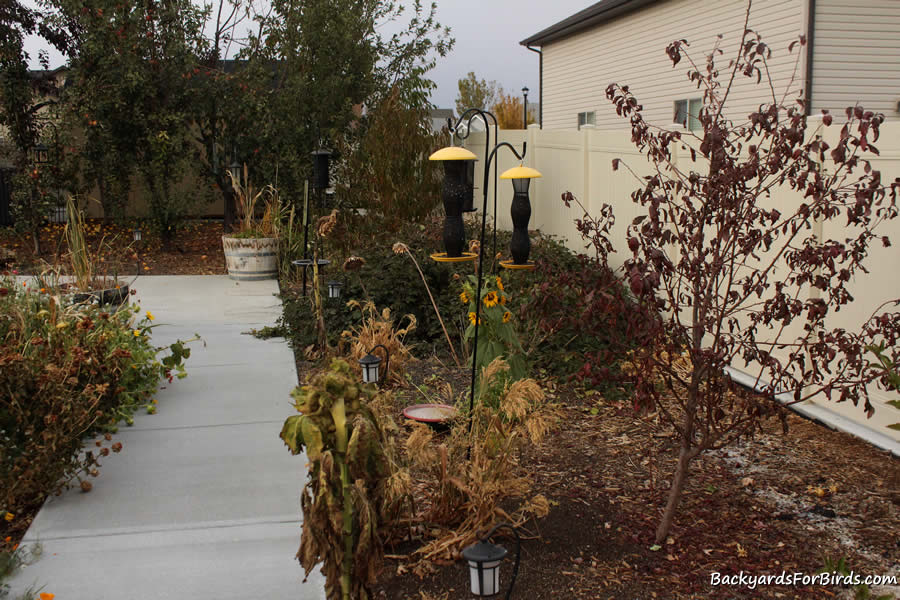
Food can be as simple as a bird feeder or as elaborate as planting some native vegetation such as trees and shrubs, for example, that provide a more natural source of food.
Water is one of the most overlook aspects of bird feeding and even by itself, providing a simple birdbath can indeed bring in many birds on its own.
The hardest part of attracting any kind of bird to the yard is providing a place for them to come to and feel safe, basically a way to hide from and even escape from predators.
Large trees, for example, provide a good place for birds to come to and hide from a common avian predator such as the cunning sharp-shinned hawk.
By providing some or all of these things, you have every chance of attracting the house finch as well as many other birds that frequent your particular region.
Let’s look at each of them in a bit more detail.
Providing cover for birds
Cover, or places birds can come to and feel safe, is by far the hardest part of attracting birds to one’s yard.
The best thing to have is large trees and thick shrubs which provide a hiding place from hawks and kestrels.
Trees and shrubs are natural places birds want to be and the more you can provide, the better it will naturally help attract birds to your yard.
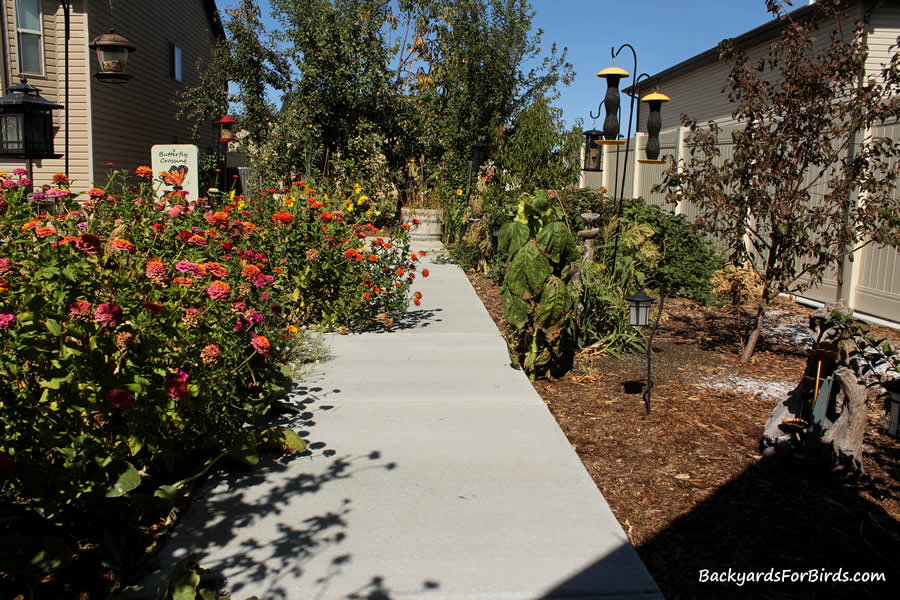
But planting large trees or thick bushes isn’t always easy or even feasible, especially in small yards.
It might not even be financially possible at the time being but there is an option available if you are wanting to provide even the least bit of cover in an otherwise barren landscape.
This past spring, we found out by chance that leaving a small but dense pile of limbs in a corner of the yard will indeed help attract quite a few birds to the yard.
The limbs don’t have to be very big in size but a decent sized pile of limbs will be needed for the birds to bury down inside and feel safe.
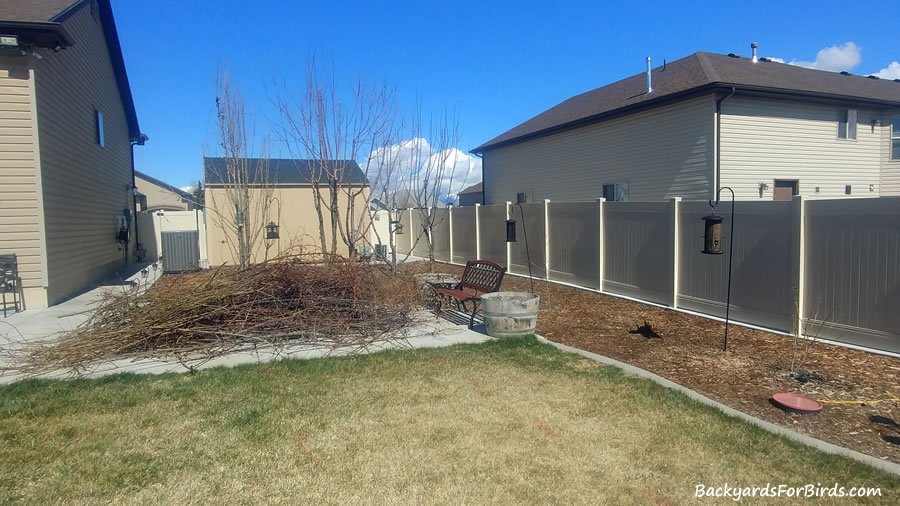
Just recently, we have watched countless times as a sharp-shinned hawk tried to go after a flock of sparrows in our yard only to be thwarted by the thick pile of limbs they were residing in.
It doesn’t always look pretty, but a dense stack of limbs can help provide some cover when planting trees or bushes isn’t an option.
If you know someone that will be pruning their trees in the spring, a pile of these cut branches can make for a quick and easy patch of cover.
A thick raspberry patch can also provide some great cover for birds when planting trees or shrubs is not a possibility.
Normally such vegetation is oftentimes cut back for the winter season but if you are going to allow it to be cover for birds, let it grow without the usual seasonal trimming.
It might affect your berry production but it could help your bird watching.
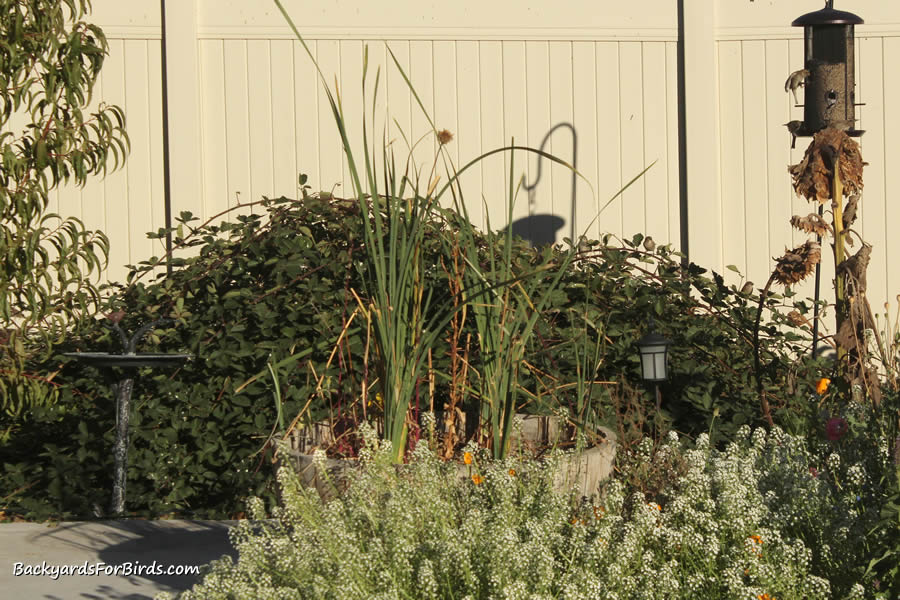
What do house finches like to eat?
House finches eat mostly vegetable matter with seeds, buds, and berries being a large portion of their diet.
Weed seeds are a preferred food source when they are indeed available. House finches will forage from the ground, clinging to weeds, and also while perched in shrubs and trees.
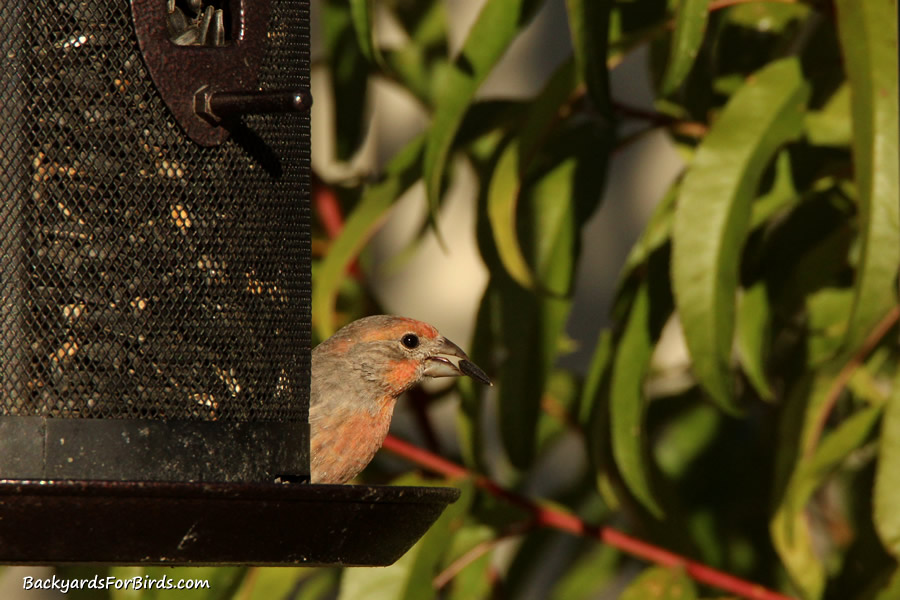
This wide variety of feeding makes them very easily attracted to backyards with even just a few trees, shrubs, or bushes, and also with many of the commercial bird feeders and mixtures available on the market.
The quickest and simplest way to attract finches is to put out a bird feeder with black oil sunflower seeds in it.
You can get a mixture of seeds with some black oil sunflowers in it or you can get straight sunflowers.
We do both but find the vast majority of the time the house finch will eat the black oil sunflower seeds over anything else we offer when there is a choice to be had.
Putting out a mixture will help attract other birds to the feeder as well so if you are looking for a variety of birds to your yard, try a simple seed mixture that has some black oil sunflower seeds in it to satisfy the house finch.
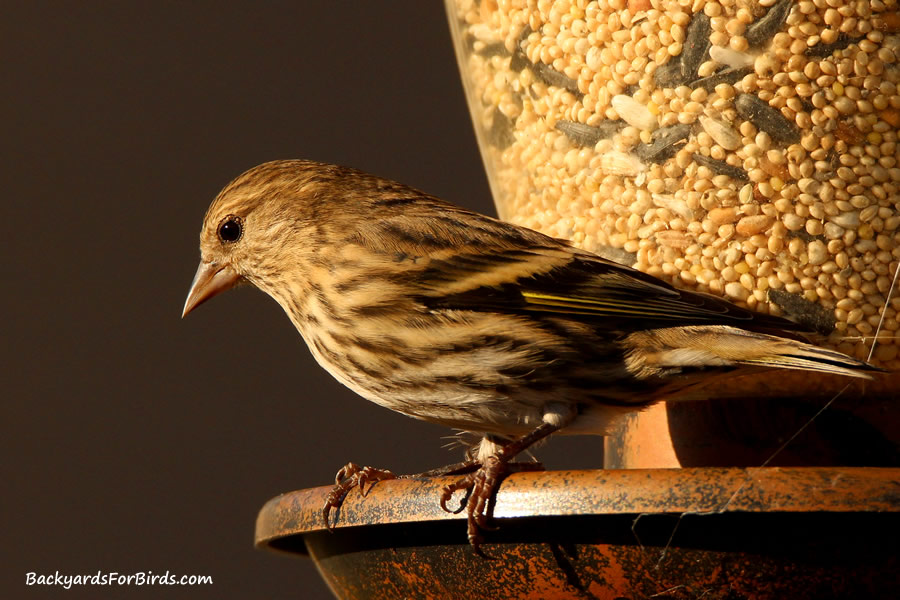
There are a lot of types of bird feeders that work well with the sunflower seeds but we like the large round styled ones as they tend to offer more feeding space for more birds at a time.
During the winter we often get dozens of house finches coming in at once and quickly emptying the feeder and these larger feeders allow for less time filling and more time bird watching.
We also put out nyjer seed for goldfinches and when the black oil sunflowers aren’t available, we do have house finches feeding alongside the goldfinches at these thistle feeders.
I have seen house finches eat nyjer seed and most other kinds of seed but day in and day out, when black oil seeds are available that is what seems to be their preferred type of food, at least at our feeders, that is.
Recently, we have discovered from trying a few different types of wild bird seed that shelled sunflower seeds attract the most house finches to the yard on a most consistent basis.
Where is the best place to hang a finch feeder?
Placing a finch feeder nearby some cover such as a bush or tree will help attract more house finches and help attract them more quickly to your backyard.
Birds like to feel safe when feeding so the closer you can put the feeder to a bush or tree, the more comfortable they will feel and will more readily they will use it.
Birds of all kinds feel safe around trees and bushes and they will utilize them whenever possible.
House finches will feed on bird feeders places out in the open but they will be more attracted to feeders placed near some trees or bushes.
Placing it near some type of tall vegetation like this will help in the birds finding the feeder more quickly as well.
Even placing the feeder nearby a small tree if that is all that is available, such as this Canada Red Chokecherry, will help the house finches feel a bit more comfortable and safe.
We placed this feeder nearby this tree and it only took a few days before a couple of house finches found it and started to regularly visit the feeder.
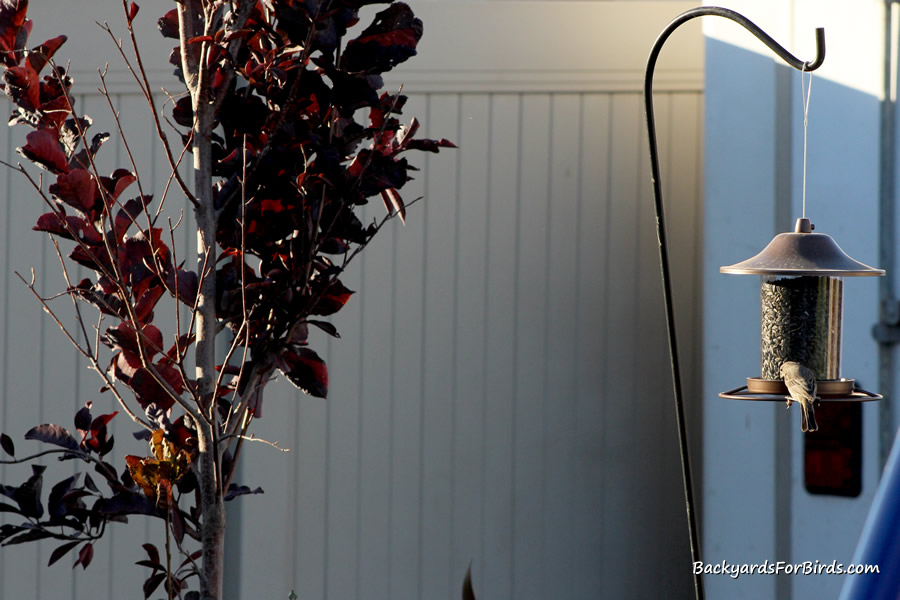
How long does it take for finches to find a feeder?
It could take a few days to a few weeks, or even longer, for house finches to find your feeder. It all depends on feeder placement, available nearby cover, and if there are house finches in your neighborhood.
When we started to put out feeders at one of our houses, it only took about a week before birds started to come to the feeders but they were placed nearby some established apple trees.
If you have house finches in your area, don’t worry and just put out a feeder in your yard near some kind of cover and give it some time.
Usually other more common birds, such as house sparrows, for example, will find it first but once even a few birds of any species find your backyard feeders it is only a matter of time before more and more birds start arriving and help attract the much-desired house finch.
House finches are very widespread and are a common bird at most feeders so if you are in an area they live in, it should only take some time and patience for them to find your backyard bird feeder.
Just place the feeder as close to some cover as possible to help speed up the process.
I have found hanging the feeder actually in a tree, if at all possible, is one of the best places to quickly attract birds to it.
Why did the house finches stop coming to my feeder?
Wet, dirty, moldy food is the most common reason birds stop coming to a feeder. Make sure your food hasn’t spoiled, which is fairly common in more humid regions.
Birdseed needs to be kept dry and if you have a lot of humidity or even frequent rain in your region, try cleaning your feeder and filling it with fresh food more often to avoid spoilage.
Don’t worry, once the feeder is cleaned and refilled the birds should again return.
It is possible someone close by is also putting out food but birds move around a lot so even if you lost them for a time being it isn’t hard to get them to come back. Just be patient.
We have found that nyjer seed, another food that house finches will eat, is very easily spoiled with a little bit of moisture but black oil sunflowers will also spoil if left out in the elements for long periods of time.
If you only have a few house finches coming to your feeder, try not filling the feeder up all the way and letting it empty more often.
This means you will have to watch your feeder more regularly to keep refilling it but it will also help with possible food spoilage and loss of bird activity in your yard if you are having such a problem.
Does putting out a birdbath help attract house finches?
A quick and easy way to almost immediately attract birds to your yard is by putting out a birdbath nearby some cover, similar to the feeder.
We do this year-round and even in our sub-freezing winters, having an ample supply of water each day attracts a lot of birds to our yards.
Birds need to drink regularly year-round and the biggest mistake we make as backyard birders is thinking birds can find water somewhere else.
That might actually be the case but even if it is, why not use water in conjunction with food to help attract them to your yard.
It is just another reason the birds will return to your yard instead of somewhere else.
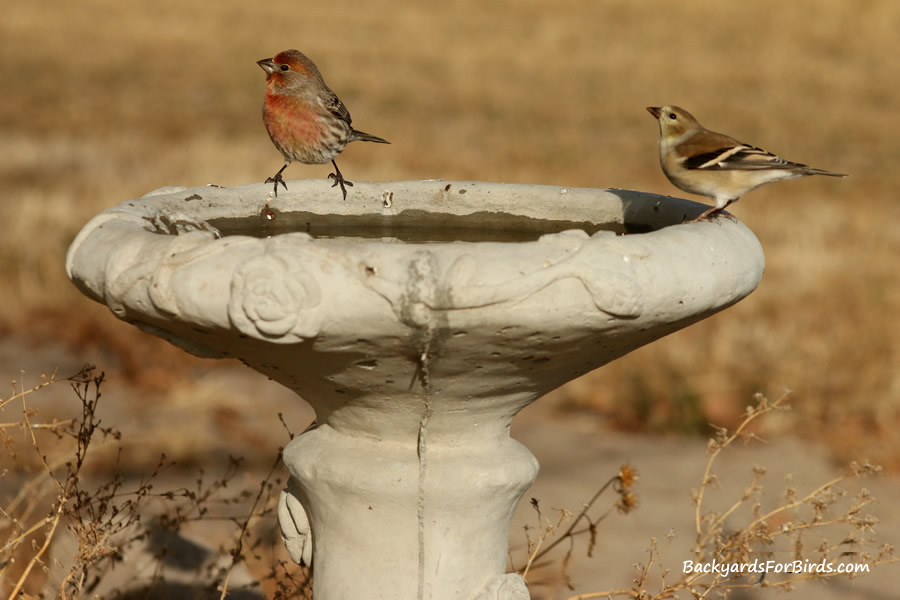
We use a variety of birdbaths and fountains, depending on the time of year.
For summer, we love watching the birds use a fountain-style of birdbath.
The sight and sound of the running water seemingly help attract the birds and the sound of the running water is a bit soothing to listen to as well.
The fountains do need to be cleaned more regularly as sometimes debris can clog the water flow but regular maintenance is a small price to pay to have such an amenity in your yard.

I have used the pedestal-style birdbath for years and still use it year-round at my own home, in fact, despite my having to pour hot water on it during the coldest parts of the winter to thaw it out.
During the summer months, numerous birds can be found in it at the same time bathing and drinking so it can attract a lot of birds at one time.
Winter is the hardest time to provide water if you are like us and live in a freezing climate.
For 3-4 months of the year, we need to deal with keeping the water thawed out even when the temperature has dropped to near 0 degrees Fahrenheit.
One of the best bird baths we have used is a simple heated pan-styled bath that has never frozen up on us yet despite some extremely cold nights where it has even dipped below zero degrees for the night.
If you have a nearby power source, this is one of the most effective ways to keep water unfrozen throughout the cold, harsh winter.
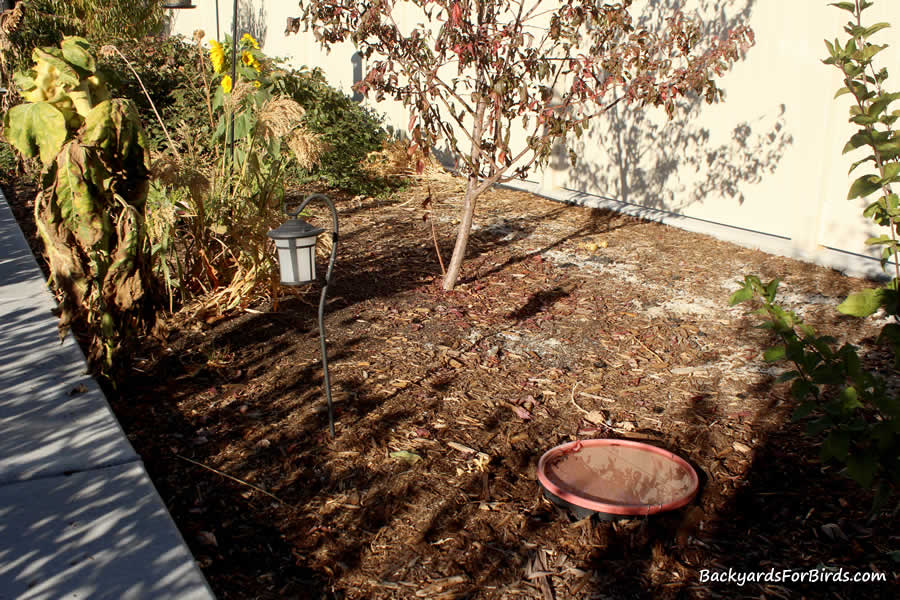
Conclusion
Attracting the house finch is a simple task really if you are in an area they are commonly found in.
By providing fresh food, water, and some cover, you can help attract not only finches but a variety of commonly found birds in your area to your very own backyard.
I have personally found very little that offers such enjoyment and relaxation as attracting birds to my own backyard.
They offer hours of entertainment as well as relaxation while interacting at both the feeder and birdbath and with a little effort and time, can do so year-round.
It’s a little bit of work and a small investment for equipment and food but the benefits of bird watching, at least in my opinion, surely outweigh the costs.
Subscribe to our blog
Don’t forget to subscribe to our blog for notifications for future blog posts about birds, butterflies, and all the other fascinating creatures we can attract to our very own yards.
Nature is fascinating and even more so when we can observe, learn, and enjoy it anytime we want in our own backyards.


